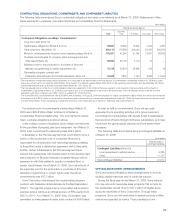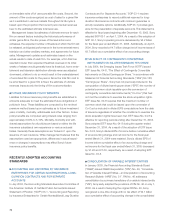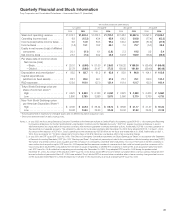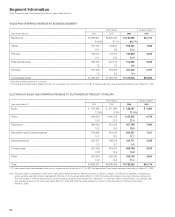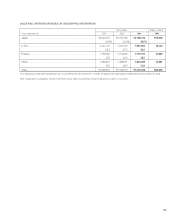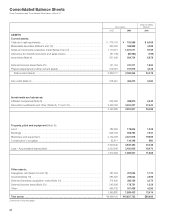Sony 2006 Annual Report Download - page 77
Download and view the complete annual report
Please find page 77 of the 2006 Sony annual report below. You can navigate through the pages in the report by either clicking on the pages listed below, or by using the keyword search tool below to find specific information within the annual report.
75
in future periods. While management believes that the assump-
tions used are appropriate, differences in actual experience or
changes in assumptions may affect Sony’s pension obligations
and future costs.
Sony’s principal pension plans are its Japanese pension plans.
Foreign pension plans are not significant individually with total
assets and pension obligations amounting to less than 10% of
those of the aggregate of the Japanese pension plans.
To determine the benefit obligation of the Japanese pension
plans, Sony used a discount rate of 2.2% for its Japanese
penson plans as of March 31, 2006. The discount rate was
determined by using currently available information about rates
of return on high-quality fixed-income investments available and
expected to be available during the period to maturity of the
pension benefit obligation in consideration of amounts and
timing of cash outflows for expected benefit payments. Such
available information about rates of returns is collected from
Bloomberg and credit rating agencies. The 2.2% discount rate
represents a 10 basis point decrease from the 2.3% discount
rate used for fiscal year ended March 31, 2005. The reduction
of the average duration of benefit payments in consideration of
amounts and timing of cash outflows for expected benefit
payments is mainly due to the fact that more retiring employees
selected lump-sum amounts instead of monthly pension
payments. For Japanese pension plans, a 10 basis point
decrease in the discount rate would increase pension costs
by approximately ¥0.8 billion for the fiscal year ending
March 31, 2007.
To determine the expected long-term rate of return on
pension plan assets, Sony considers the current and expected
asset allocations, as well as historical and expected long-term
rates of return on various categories of plan assets. For Japa-
nese pension plans, the expected long-term rate of return on
pension plan assets was 3.2% and 3.5% as of March 31, 2005
and 2006 respectively. The actual gain on pension plan assets
for the fiscal year ended March 31, 2006 was 10.6%. Actual
results that differ from the expected return on plan assets are
accumulated and amortized as a component of pension costs
over the average future service period, thereby reducing the
year-to-year volatility in pension costs. As of March 31, 2005
and 2006, Sony had unrecognized actuarial losses of ¥322.2
billion and ¥169.9 billion, respectively, including losses related to
plan assets. As a result of the transfer to the Japanese govern-
ment of the substitutional portion, unrecognized actuarial losses
related to the substitutional portion was recognized as a
settlement loss. Therefore unrecognized actuarial losses were
reduced. The unrecognized actuarial losses reflect the overall
unfavorable return on investment over the past several years
and will result in an increase in pension costs as they are
recognized.
Sony recorded a liability for the unfunded accumulated benefit
obligation for Japanese pension plans of ¥128.6 billion and
¥35.8 billion as of March 31, 2005 and 2006, respectively. This
liability represents the excess of the accumulated benefit obliga-
tion under Sony’s qualified defined benefit pension plans over
the fair value of the plans’ assets. This liability was established
by a charge to stockholders’ equity, resulting in no impact to the
accompanying consolidated statements of income.
The following table illustrates the sensitivity to a change in the
discount rate and the expected return on pension plan assets,
while holding all other assumptions constant, for Japanese
pension plans as of March 31, 2006. As benefit obligation and
plan assets decreased due to the transfer to the government of
the substitutional portion, the sensitivity also decreased.
CHANGE IN ASSUMPTION
Yen in billions
Pre-tax Pension Equity
PBO costs (net of tax)
25 basis point increase /
decrease in discount rate. . . –/+24.7 –/+2.0 +/–1.2
25 basis point increase /
decrease in expected
return on assets . . . . . . . . . . — –/+1.2 +/–0.7
■DEFERRED TAX ASSET VALUATION
Sony records a valuation allowance to reduce the deferred tax
assets to an amount that management believes is more likely
than not to be realized. In establishing the appropriate valuation
allowance for deferred tax assets (including deferred tax assets
on tax loss carry-forwards), all available evidence, both positive
and negative, is considered. Information on historical results is
supplemented by all currently available information on future
years, because realization of deferred tax assets is dependent
on whether each tax-filing unit generates sufficient taxable
income. The estimates and assumptions used in determining
future taxable income are consistent with those used in Sony’s
approved forecasts of future operations. Although realization is not
assured, management believes it is more likely than not that all of
the deferred tax assets, less valuation allowance, will be realized.
■FILM ACCOUNTING
An aspect of film accounting that requires the exercise of
judgment relates to the process of estimating the total revenues
to be received throughout a film’s life cycle. Such estimate of a
film’s ultimate revenue is important for two reasons. First, while a
film is being produced and the related costs are being capital-
ized, it is necessary for management to estimate the ultimate
revenue, less additional costs to be incurred, including exploita-
tion costs which are expensed as incurred, in order to determine
whether the value of a film has been impaired and thus requires


